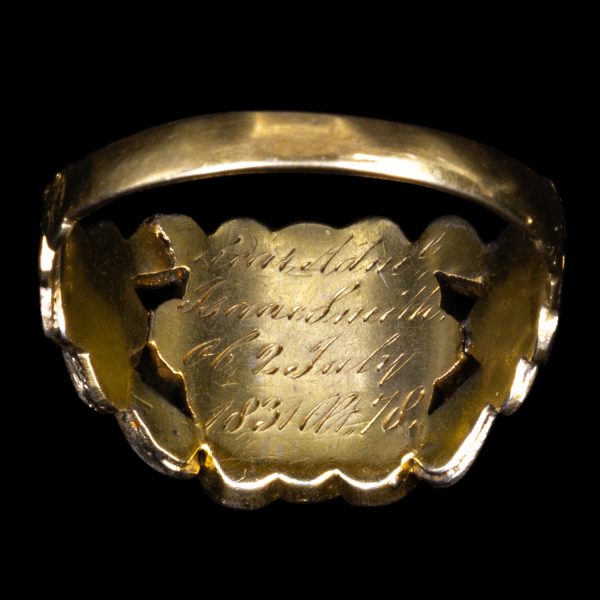Article
Mourning ring for Rear-Admiral Isaac Smith, the first member of the Endeavour’s crew to set foot on land at Kamay (Botany Bay) in April, 1770.
[London : maker unknown, ca. 1831]. Diamond, pearl and enamel set into a gold ring with the following inscription engraved on the inside of the band: ‘Rear-Adml Isaac Smith Ob 2 July 1831 Ob 78′. Housed in a crimson morocco box with brass clasp.

An extraordinary survival: a mourning ring for the memory of Rear-Admiral Isaac Smith (1752-1831). Smith is distinguished for being the first Englishman to set foot on the east coast of the Australian continent.
As a 17-year-old, on 29 April 1770, Smith was the first to go ashore from HM Bark Endeavour‘s yawl on the south side of Kamay (Botany Bay), ahead of Lieutenant James Cook, Banks, Solander, Parkinson, the Tahitian Tupia, and a party of armed marines accompanying them in the ship’s pinnace and long-boat. The landing was made after the intruders had been challenged by two Gweagal warriors, and musket shots had been fired. Cook ordered the young man to ‘Jump out, Isaac!’
Although Smith’s stepping onto Gweagal land carries with it immense symbolic significance, it should also be noted that Smith was one of three men, including Lieutenant Zachary Hicks and Surgeon William Monkhouse, who collected short lists of words from the language of the Gweagal with whom they interacted during the Endeavour‘s brief sojourn at Kamay. These words survived in a manuscript that was later compiled by William Lanyon, a shipmate of Smith on Cook’s second voyage. Fortunately, this manuscript was published in 1979 by Lanyon’s descendant, linguist Dr Peter Lanyon-Orgill, prior to its being lost. The existence of these word-lists suggests that at least some friendly encounters between the Europeans and the Gweagal must have taken place.
Smith served on Cook’s first and second voyages to the Pacific. He was related to Cook by marriage, as he was the cousin of Elizabeth Cook, the commander’s wife. On both voyages – on the second, as master’s mate – Smith assisted with surveying and cartography. He was given his own command after his return from the second voyage in 1775. He continued to serve in the Royal Navy until 1794, when ill-health forced his retirement. Smith spent his remaining years domiciled in Clapham with his cousin, Elizabeth Cook, where he died in 1831.
In his will, dated 18 December 1827, Smith bequeathed ‘unto my dearest Cousin Mrs Eliz Cook of Clapham in Surrey two hundred guineas for a ring and mourning and all or any part of my effects in plate books or furniture at her house at Clapham she may choose to accept as a mark of my great regard and respect for her knowing she does not wish a larger legacy.’ He also left nineteen pounds for the son and daughters of his late cousin Charles Smith ‘for a ring of remembrance‘ and eighteen for the same to both Elizabeth Ann Stuart and Mary Marston. The Captain Cook Museum in Whitby holds one of the aforementioned rings, which is identical in all respects – including the engraved legend – to the ring offered here. It is likely that all of these rings were made by the same jeweller.
Available for sale at Douglas Stewart Fine Books for $48,000.
By Jonathan Dickson
Douglas Stewart Fine Books
Additional photos and information on this ring can be found here.
AAADA Antiques & Art Fair Sydney
1-3 September 2023
The Great Hall – University of Sydney
aaada.org.au/sydney
Tickets on sale now SYDNEY
Buy your tickets online for a chance to WIN $1,000 to spend at the AAADA Antiques & Art Fair Sydney and a AAADA representative will take you around the fair providing you with guidance as you browse. All admission tickets purchased to either fair online are automatically entered for their corresponding location. For eligibility check our T&Cs on our website. Entries for Sydney close 5pm on the 29th of August 2023 (AEST).
Click for a full list of our dealers, service providers & Decorative Arts & Collectors Societies
